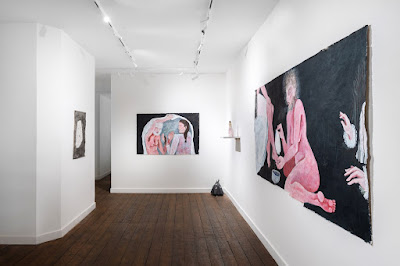Matilda Sutton at Pipeline Contemporary
Where is Feminism these days? Has anyone called her, is she okay?
If an alien species were to conduct a David Bowie-Man Who Fell to Earth-style research experiment into what feminism is in 2024, and what its congruent objectives are, they may find themselves with a difficult task. I'm being facetious here, clearly, but perhaps it wouldn't be such a mystery, based on which strands of the fight are the most visible. Considering the sorts of people who spearhead mainstream (or "white") feminism's capitalist agenda, our alien friend might be encouraged to find that there are now more women in the boardroom, we're now "sexually liberated", we can marry for love, we can get divorced, and vote, and roam around public spaces safely... oh wait. Fully embracing my own tear-stained humour, I decided to search "feminism" into LinkedIn, which is its own non-geographic, virtual corporate hellscape. Assuming I would find more Girlboss rhetoric, I was surprised to find a range of issues being discussed. From 'Me Too' to an Emma Watson UN speech whereby she denounces man-hating, and international development thinkpieces, feminism is arguably more networked and complex than it has ever been, for good and bad.
Women artists are often bundled together with an assumption that they share the same values, are working to the same cause, bearing similar aesthetics, and have something inherent in common. Something unspeakable! Even women's inclusion in art history, whether you want to assess it by the book or by what you know, the expectation that womanhood is a loving and static community is largely bogus (one only need look at the division stoked by so-called "radical feminists" towards trans women, or others watching on as the rights of migrant and refugee women dwindle). How much of this is a self-fulfilling prophecy? Women artists certainly seem more inclined to make artworks investigating the body, almost as if cisgendered men simply get on with it, while women are inherently curious as to how they are spatially perceived, what they look like, and what the conundrum of simply existing in a femme-presenting body means to oneself and the wider world.
What happens when we break free of the binary? I don't mean that in some hyper-intellectualised, academic sense. What really happens when we analyse our movements, our routines, our mannerisms, and realise that they are conditioned? Most of us are arguably too far deep to rip off the band-aid all at once, but Matilda Sutton's work at Pipeline Contemporary provides a comic but impassioned insight into what this world might look like. The backgrounds of the artist's canvases are markedly bleak and barren; blackness absorbs both sky and ground level, as we see figures that lie between human and animal undertake fairly mundane tasks. In Groundwork, a static-haired figure washes the feet of another, and there is something oddly relaxing about the servitude we observe in the painting. It is certainly not romanticised; I am more inclined to think of Andrea Solario's sixteenth century painting, Salome with the Head of Saint John the Baptist, than a more traditional form of women or slaves (the two not being mutually exclusive) adhering to the needs of wealthy figures in art. Instead in Sutton's work, we are anchored by a shared kinship, one that is no longer gendered, but instead divided by need and ability.
The paintings hung on Pipeline Contemporary's walls are fearless and bold. With frayed edges and unfinished narratives, we are seeing not what Pretty looks like, but what Life looks like. My body is not the boat is strikingly rich with voice. You can't help but feel caught up in the story, and indeed the peril. Our protagonist is not drowning, their arms are not flailing for help, but the expression of pain and anguish is palpable; grey roots expand down to their ears, and they seem to be communicating with a white rockface, which bears an unnerving resemblance to a human visage. An ominous black bird extends their wings in the background and it has the impact of a book you don't want to put down. The torn parallel edges of the canvas add to this even more. A sucker-punch of a painting that is so rare in its quiet horror.
The space could hold the four paintings and stand strong as an exhibition. If anything, the content of the paintings seem to outgrow the gallery, but accompanying sculptural pieces are also to be found in interesting and charming spots around the space, from a plinth in the window to a tiny corner at the back of the room. There is certainly a sense of the macabre about them; unlike the glossy facades of women that we see on social media and in advertising, you certainly don't want to be these little creatures. They're in, frankly, inexplicable positions and predicaments, and the chasm between them and the world we are supposed to strive for is exhausting.
Such an overt rejection of feminine aesthetics, towards a nod to posthumanism and trans-species psychology, is refreshing, raw, and wild. This is the case to the extent that it feels almost funny, perhaps farcical to witness it in the straight, whiteness of a commercial gallery space. The potential of exhibiting work like this feels not only progressive but limitless.





